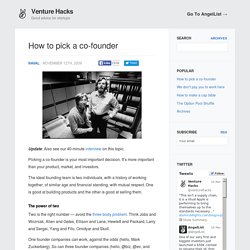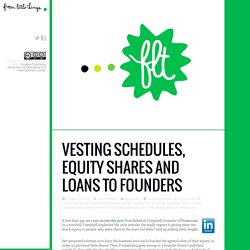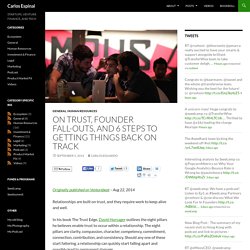

How to pick a co-founder. Naval · November 12th, 2009 Update: Also see our 40-minute interview on this topic.

Picking a co-founder is your most important decision. It’s more important than your product, market, and investors. The ideal founding team is two individuals, with a history of working together, of similar age and financial standing, with mutual respect. One is good at building products and the other is good at selling them. The power of two Two is the right number — avoid the three-body problem. One founder companies can work, against the odds (hello, Mark Zuckerberg). Two founders works because unanimity is possible, there are no founder politics, interests can easily align, and founder stakes are high post-financing. Someone you have history with You wouldn’t marry someone you’d just met. One builds, one sells The best builders can prototype and perhaps even build the entire product, end-to-end. The seller doesn’t have to be a “salesman” or “business guy”. Aligned motives required Don’t settle FAQs.
KOUDETAT : Le Dilemme du Cofondateur [FR] Questions you and your co-founder need to have answered before you start (or ASAP) Equity basics: vesting, cliffs, acceleration, and exits. As a cheatsheet, the “normal” equity structure is: Founder terms: 4 year vesting, 1 year cliff, for everyone, including youAdvisor terms (0.5–2.0%): 4 (or 2) year vesting, optional cliff, full acceleration on exit Getting equity structures right When it comes to equity terms, there are only 3 things to understand: vesting, cliffs, and acceleration.

For these examples, let’s say that I’ve got a co-founder and we’re splitting the company 50/50. The problem we want to avoid is if one of us decides to quit early on, taking half the company’s stock with us. Cliffs & vesting Vesting is how we fix that. Vesting means that instead of each getting our 50% immediately, it gets given to us regularly over some period — usually 4 years.
A problem this can lead to is that you can end up with loads of people who each own a tiny percentage of the company. Cliffs basically allow you to “trial” a hire or partnership without an immediate equity committment. Vesting schedules, equity shares and loans to founders. A few days ago we came across this post from Rebekah Campbell, Founder of Posse.com.

In a nutshell, Campbell explained the only mistake she really regrets is giving away too much equity to people who were there at the start, but didn’t end up pulling their weight. Her proposed solution is to have the business lend each founder the agreed value of their equity, in order to purchase their shares. Then if something goes wrong or a founder doesn’t pull their weight (in line with the shareholders agreement), the company rescinds the loan, and takes back the equity.
There are some potential issues with this approach, which we’ll outline below. Founders leaving early or not pulling their weight is an issue faced by plenty of startups, says Niki Scevak, co-founder of Startmate and the recently launched Blackbird Ventures. “It really is the most important thing,” says Scevak. Establishing a vesting schedule: what does it mean?
The vesting cliff Loan to purchase shares Am I breaking the law? On trust, founder fall-outs, and 6 steps to getting things back on track. Originally published on Venturebeat – Aug 22, 2014 Relationships are built on trust, and they require work to keep alive and well.

In his book The Trust Edge, David Horsager outlines the eight pillars he believes enable trust to occur within a relationship. The eight pillars are clarity, compassion, character, competency, commitment, connection, contribution, and consistency. Should any one of these start faltering, a relationship can quickly start falling apart and possibly lead to permanent damage. In the craziness that is an early-stage startup, where founder roles are sometimes ambiguous to start with (even more so with leading co-founders), it’s no surprise that many of the reasons for companies falling apart are related to founder disputes and loss of trust between co-founders.
Note: On this post, the focus is not about whether companies that have a clear CEO are better off than those that are joint efforts from the start. So what can you pro-actively do? 1. 2. 3. 4. 5. 6.